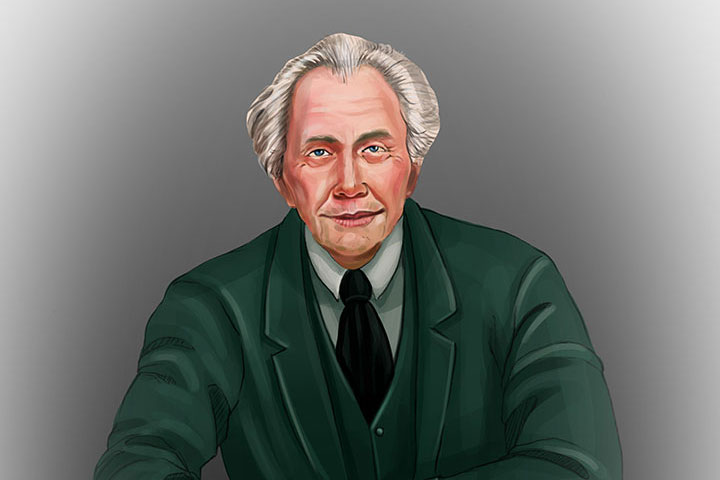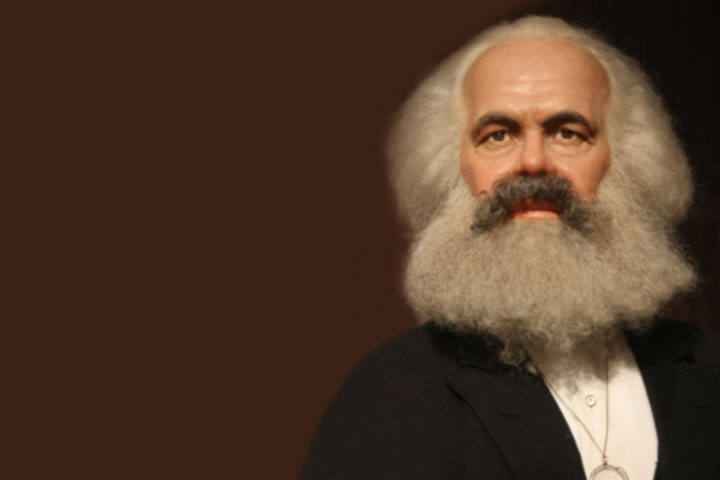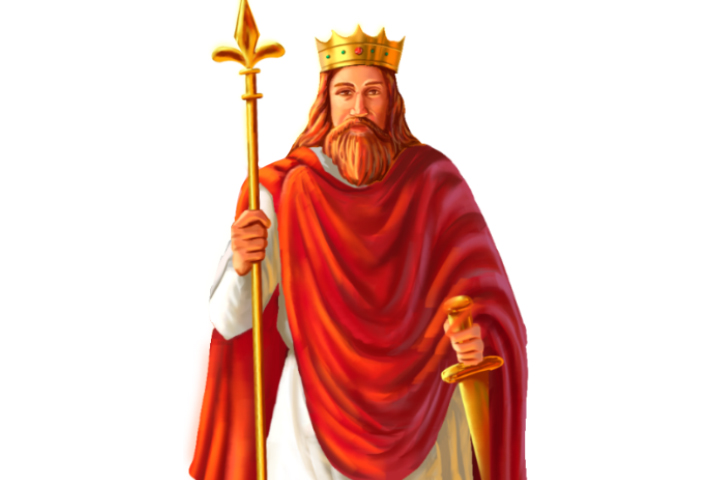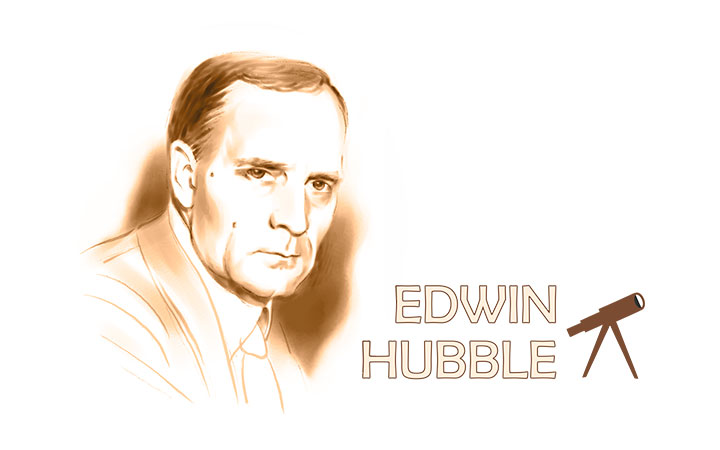
A celestial romance embracing stars, encompassing planets and bringing the heavens down to earth…the kind that swallows you whole, leaving space for nothing else… strengthened by eons of time and shackles of devotion. An obsessive romance that commenced its budding at a young age and shone prismatic radiances on the distant astronomical horizon. Very unlike the mushy vampire-human junk that’s doing the rounds nowadays which far from benefited literature or any other field for that matter.
I guess you’ve had enough of my vibrant narrative so now let’s get down to business. The idea I was trying to impress upon you is the fixation of the 20th century American astronomer Edwin Hubble with the Universe! Wait! Don’t click the red cross on the top right-hand corner of your screen just yet! It gets interesting. Old Edwin explored the size, structure and properties of the Universe and earned himself a place among the likes of Galileo and William Herschel. And that’s saying something, as Galileo was dubbed the “father of modern observational Astronomy” and William Herschel I-spied-with-his-little-eye with the planet we all know today as Uranus. Hubble outshone most of the oldies and their assumptions with his new observational approach to the science of the universe and analysis of the empirical data. Hubble favoured a holistic approach when it came to cosmological investigations, giving to the world of Astronomy a steady foothold on which to elaborate. However, his journey to the top has not been a smooth one-way ride; quite the contrary it was a path that was scattered with many obstacles, dilemmas and uncertainties that buffeted him left and right through thick and thin to the point, where he finally achieved his life’s ambitions.

The wiz-kid, Edwin Powell Hubble, was born in a Springfield dwelling to John Powell Hubble and homemaker Virginia Lee James in Marshfield, United States, on 20th November, 1889. He was the third offspring preceded by his sister Lucy and brother Henry, and followed by Virginia, William, Helen, Emily and Elizabeth (not necessarily in the same order). The genes of an insurance agent and homemaker combined to formulate a collection of remarkable individuals characterized by a rare pioneering spirit, passionate patriotism and a lively sense of adventure.
Edwin Hubble’s childhood was moulded in a smoky environment by a tobacco loving, pipe puffing, cigar smoking father - John Powell Hubble. His absence from the Hubble household for weeks together, sometimes as long as six weeks at a stretch, was due to the travelling nature of his job. Don’t go judging him too quickly though. Mr. Hubble’s personality was underlined by firm moral principles and an ever-burning ambition. He renounced alcohol and rarely ever cursed. He played the part of a tough taskmaster to his kids owing to the fact that he in turn was brought up in a strictly pious environment. Though his belief in the Bible was infallible, he had little time to spare for the Church. His marriage to Edwin’s mother, Virginia aka Jenny, made them an excellent example of the opposites-attract theory. If Mr. Hubble was at the north end of the pole, Virginia was most definitely sitting pretty in the South. Her role in the Hubble household was that of a safety-net to her children. Every time her husband got carried away with the task of disciplining the kids she didn’t hesitate to bring him back with a gentle nudge about an embarrassing episode that never failed to make him stop. The incident had Mr. Hubble escort one of his daughters to a vaccination where the child fainted almost immediately followed by Mr. Hubble himself. Though the kids dutifully obeyed Mr. Hubble, Mrs. Hubble was the one who scored the brownie points in making them feel comfortable and they chose her when they needed someone to confide in. Mrs. Hubble was a fine lady with a charming personality, coloured with an appealing sense of humour. Like her husband she too was well versed with the Bible and taught women at Sunday school, but unlike him was not overtly religious.
Edwin’s childhood experiences were a far cry from his comrade. The saying “once bitten twice shy” which applies to most of us simply bounced off this little fellow. In a scene from his childhood that goes on to prove our above claim almost literally, Edwin recalls a day of his childhood when he was left alone to play in a garden. A tired Edwin accidently stumbled against an approaching dog and it bit him. Now the typical reaction of a child to this situation would be to run crying to his parents, but not our Edwin. He timidly approached the dog, pitying him, and gently patted it. Consequently, young Edwin made a new friend and he wasn’t alone in the garden anymore.

In October of the year 1895, Marshfield saw a six-year-old Edwin attend his first day of school. Only to find him protesting against not being allowed to attend classes with his elder brother and sister and justifiably so; young Edwin there was not only able to read a cipher but draw one too, an astonishing feat for kid who hadn’t even started first grade yet. He was intellectually ahead of his classmates and soon grew bored and disinterested, turning out to be a handful for his teachers. And if that were not enough, things back home proved to be just as troublesome. A metropolis of carefully constructed bridges and toy castles erected by Edwin and his brothers were repeatedly brought down by their kid-sister, fourteen month old Virginia. The demolished buildings were avenged callously, with the brothers stepping on little Virginia’s fingers. Of course no misdemeanours in the Hubble household, under the eyes of Mr. Hubble went scot-free and the boys were duly punished. But before they knew it little baby Virginia was down with a mysterious disease and despite the parents’ desperate attempts to cure her, she succumbed to it in January 1896. Young Edwin was left with a lingering survivor’s guilt stemming from the deluded perception that the injuries caused by him and his brothers were responsible for the demise of their little sister. He plunged into grief and depression, taking a long time to resurface from the trauma.
A young Edwin had an ardent desire to gaze at the heavens through the eyepiece of a telescope. Finally, on his eighth birthday this wish was granted by his fairy grandfather or more realistically his maternal grandfather – William James – a benevolent doctor and creator of the telescope through which Edwin Hubble had the first glimpse of the universe.
Sam Shelton, a schoolmate, recalls the ten-year-old Edwin excitedly announcing a looming total lunar eclipse; the boys convincing his parents to let him watch the remarkable phenomenon, the spellbinding rapture and revelation in an open space continuing well past midnight! Sam reliving the night later said, “We spent most of it in the open spaces, where the view of the sky was unobstructed. To us it was a magnificent show.”

By the fourth grade Edwin discovered the delights of reading. He visited Lewis Carrol’s Alice in Wonderland, took a peek Through the Looking Glass, adventured alongside Mowgli in Rudyard Kipling’s Jungle book, worked his little grey cells with Conan Doyle’s Sherlock Holmes and a lot more. Edwin’s paternal grandfather, Martin Hubble, was a fine storyteller and Edwin learnt much of American history from the old man.
Came 1901, and the 12 year old Edwin was now a student at Wheaton High School, Wheaton. This time the teaching faculty gave in to the fact that he was ahead of the other students his age and positioned him with the eighth graders. His overall performance was average (owing mainly to spelling errors), accompanied by behaviour that was far from desirable and before he knew it day dreaded by many a student came to pass – Report day! The report card earned him a telling-off from his father, the effects of which were dramatically improved performances in the ninth grade.
All work and no play made Jack a dull boy. Edwin took the hint and picked his favourite sport – football, and excelled in it, while also participating in track events. His childhood could paint a canvas with colourful country wanderings spent in bird and animal watching, swimming, and ice skating, and shade it with regular spankings that were doled out when instructions that were expected to be obeyed unquestioningly, were not. Looking back at those times, Edwin approves the discipline with a grateful, “It did me a lot of good”.
The summer jobs got Edwin his first pay working as a humble newspaper delivery boy in Wheaton. At 14 years of age he was diagnosed with appendicitis and the consequent surgery left him bedridden for a couple of weeks. Now although this might not strike you as significant, this bedbound state got him reading books on Astronomy and was some of the early indications of his interest in Astronomy.
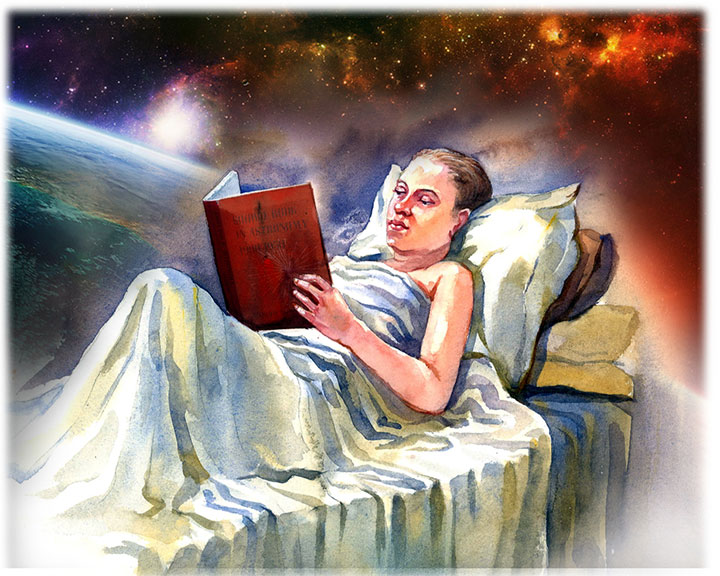
Edwin was engrossed with the subject, “But Papa wouldn’t let him go through school if he was going to be a thing so outlandish,” recalls his sister Helen.
At long last came high-school commencement on the 14th of June, 1906, and Edwin was summoned by the principal. “Edwin Hubble, I have watched you for four years and I have never seen you study for ten minutes”, said Mr. Principal and paused; having Edwin experience one of the longest most agonizing silences of his life (we reckon that pause achieved the desired effect); Mr. Principal continued, “Here is scholarship to the University of Chicago.” However, due to a mix-up the scholarship was also awarded to another student and the money was halved. Consequently, Edwin arranged for the rest by offering tuitions and working as Robert Millikans’ laboratory assistant who was an assistant professor at the University of Chicago. Edwin also bagged a scholarship in Physics in his junior year.
Seventeen-year-old Edwin then enrolled for a Bachelor of Science course and in his first year took up courses in Algebra, Analytic Geometry, Trigonometry, Inorganic Chemistry, English, Physical Culture and Descriptive Astronomy. Of the avant-garde faculty that comprised of Albert Abraham Michelson (Professor & Head of Department of Physics), winner of a Nobel Prize for his work on measuring the speed of light; Robert Andrews Millikan, (Associate Professor who taught the Electricity and Light course, apart from Mechanics, Molecular Physics and Heat) winner of the 1923 Nobel Prize for Physics, for his work on measuring the value for an electronic charge, young Edwin was most impressed by Forest Ray Moulton – Associate Professor of Astronomy, and went on to take several courses in Astronomy with him.
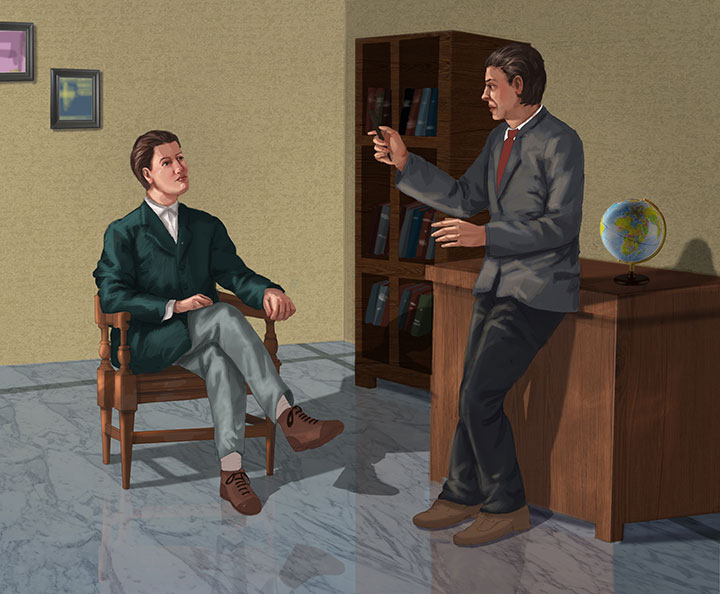
Who said nerds can’t be jocks? The fear of injury lead Edwin’s mother to compel him to quit football and the impish young lad joined basketball instead, becoming a member of the team that won the championship for the West in 1909. He also pulled on boxing gloves and was so good at the sport that he was urged by promoters to turn professional. Edwin was an all-rounder, excelling in both academics and sports and his successes instilled confidence and crafted a brilliant young man, resourceful and strong enough to take on any challenge that came his way. The year 1910 delivered the 21 year old his ‘Bachelor of Science’ degree from the University of Chicago.
Edwin spent the summer vacations working in the woods around the Great Lakes as a surveyor and engineer. He braved the border towns that were then considered unsafe. Proof of this bravery was demonstrated one evening when a pair of thugs confronted Edwin as he was walking past the railroad yard. He merely laughed at them and strolled on but got stabbed in the back below his shoulder. He turned and knocked one man down while the other took flight.
“We could have killed a porcupine or small game, but there was no need and anyway there was plenty of water.” Nonchalantly remarked Edwin on an incident where he and a co-worker, who were the last to leave, were left marooned due to an unexpected change in the railway schedule compelling them to walk out of the woods for three days without food.

Edwin won the prestigious Rhodes Scholarship owing to pure academic excellence and remarkable athletic prowess, backed by impressive recommendations by his elite faculty. The worthy winner bagged three years at Oxford and an annual grant of $1500. And though he was a Science major and Astronomy was at the heart of all interests, he went on to study Law. “Why would he do that?” you will ask. Well, we reckon he wasn’t up for a “good licking” this time around and keeping with his father’s wish took up Law as a career.
He finally settled down at Oxford, read Roman and English Law at Queen’s College, studied Literature and Spanish and made many friends in campus. Edwin was a picture of the typical Englishman with the customary cap and cane and an English accent to go with it. He was without doubt a good student and studied Law but his heart was not in it… it belonged to his childhood sweetheart – Astronomy! And even as he laboured on with his course, not willing to upset his father, his frustration grew. This was plain in the lamenting letter he wrote to his mother which went like this: “Labour which is labour and nothing else becomes an aversion. Work, to be pleasant, must be towards some great end, an end so great that dreams of it, anticipation of it overcomes all aversion to labour. So until one has an end which he identifies with his whole life, work is hardly satisfactory.” He did spend time with Herbert Hall Turner – Professor of Astronomy and Director of the University Observatory and conveniently neglected mentioning this to his parents.
Legal Studies at Oxford never came in the way of sports, and Edwin excelled in it becoming an Oxford Blue, (official colour of the University of Oxford and associated with their official sports teams) taking part in track events, boxing and rowing. Edwin was quite the popular kid at Oxford and had many friends. He was always down for some fun whilst his father maintained a steady stream of letters listing the virtues of abstinence and merits of staying true to the Christian ethics. This guidance did not suit Edwin’s temperament. He was impatient with blind faith in religious rituals and practices. In January 1913, a 24 year old Edwin lost his father to a chronic case of malaria, complicated by unexplained headaches and hypertension. By this time he had completed his legal studies however and returned to the United States.
Edwin returned home to find the family finances balancing precariously on count of his father’s prolonged illness in the last couple of years. He got to work right away, translating legal documents for an import company to stabilize the present financial conditions with a little help from his sister Lucy. He passed up the bar exam and was a no-show at the Circuit Court Judge for the inspection, which would then deem him eligible to practise Law. Edwin’s younger brother William, a graduate from Wisconsin enlisted in the army and also helped to support the family.
Edwin made an excellent teacher at New Albany High School which he joined in the autumn of 1914.
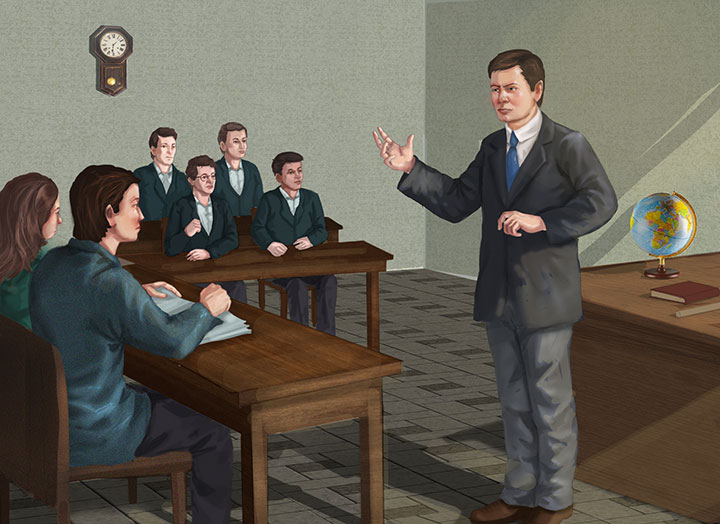
Popular and loved among the students, he taught Physics, Mathematics and Spanish while also coaching the students’ basketball team. So loved was he that the school yearbook dedicated to him read, “To our beloved teacher of Spanish and Physics, who has been a loyal friend to us in our senior year, ever willing to cheer and help us both in school and on the field, we, the Class of 1914, lovingly dedicate this book.”
May 1914 brought the end of a school term and Edwin decided to seriously pursue his passion and finally “chucked law for Astronomy, and I knew that even if I were second-rate or third-rate, it was Astronomy that mattered”, Edwin wrote to Forest Ray Moulton, his former Astronomy professor at Chicago, checking on his prospects of entering university again with some financial assistance. Moulton in turn wrote to Edwin B. Frost, Director of Chicago University’s Yerkes Observatory, recommending Edwin’s case. Frost welcomed Edwin to begin his Astronomy study at the Yerkes Observatory, offering a $120 tuition scholarship, plus $30 a month for room and board. Impressed by Edwin’s progress, Frost got his fellowship increased to $320 from the second year onwards. Edwin then made some extra money by taking a class in Introductory Astronomy. He also served as Head of Snell Hall at the university, which housed some disorderly elements in the campus. But “They never gave me any trouble, partly perhaps I had been a Chicago man and because I boxed”, presumed Edwin who had once appeared in an exhibition bout with the French boxing champion Georges Carpentier.

In 1916, following the soon-to-be commissioned 100-inch reflecting telescope, Walter S. Adams, Assistant Director of Mount Wilson Observatory, wrote to his superior George Ellery Hale, Founder Director of Mount Wilson Observatory, about the need for recruiting new astronomers. Adams, through his contacts at the University of Chicago, came to know about Edwin and recommended his name to Hale. The Director in turn spoke to Edwin Frost and Henry Gale (Physics Professor at Chicago University), and they both confirmed Edwin’s excellent credentials. Based on this feedback, George Hale offered Edwin a staff position at Mount Wilson at $1200 a year, subject to his completion of his PhD.
Edwin duly completed his dissertation and was ready to walk through the doors of astronomical opportunity held open by Hale. However, there was a raging at the back of his head; an outcome of World War I. And what Edwin did next very few young men in his position would. The next morning Hale received a telegraph from Edwin that read, “Regret cannot accept your invitation. Am off to war.” This was an impressive demonstration of Edwin’s deep sense of patriotism, moral fibre and confidence. Hale not only graciously agreed but also assured Edwin that he would have a place at Mt. Wilson on his return from the army.

Edwin was commissioned as Captain in 343d Infantry 86th Division, and was later promoted as Major. Edwin was posted in France where he served as a field and line officer. He had many interesting experiences and encounters in the army. One of them reflects his innate confidence and engaging sense of humour. Following is the story of how Edwin made food-poisoning cases a myth among his men. On his first assignment Edwin was to take army discards to camp. An armed guard brought two such men in handcuffs to him. Edwin said to the two, “I have enough to do without looking after you.” Then turning to the guard, he continued, “Take the handcuffs off these men.” Full of gratitude, the men in turn offered to inspect food supplies for any spoiled food, as they were experts in the field. Thus there were no traitors and no sick men in the long, hard trip and of course the no more food-poisoning cases. You may label this one as cheeky or witty, but the following incident was recorded in the history-sheet of the 86th Division. One of the Commanding General’s strict orders was that whenever he met an officer, the latter should immediately stop work, stand at attention, salute, give his name and rank, and narrate his activity of the moment. One morning as Edwin was riding a bicycle on the drill-field, he bumped into the General. Immediately he dismounted, saluted and said, “Good Morning, General, nice day Sir.” The General snapped back, “Major, can it be that you do not know what my orders stipulate, on the procedure to be taken by an officer whom I meet?” to which the young Major looked straight into the General’s eyes, saluted, hopped on the bicycle and said, “Sir, Major Edwin, 86th Infantry, getting on his bicycle and riding away.”
In November 1918, Edwin suffered an injury from a bursting shell. He was down with a concussion and a damaged elbow. After the suspension of hostilities, Edwin was asked to serve as judge advocate on court-martials, because of his legal background. He later became the administrative head of the American officers assigned to the universities of Oxford, Cambridge and Wales. He was well aware and deplored the evil effects of war but enjoyed the strict army life. The simple hard living under campaign conditions, the frugal rations, the strict discipline, the spirit of adventure and above all, the living and working together with fighting men, held a special charm for Edwin. In the summer of 1919, the thirty-year-old Edwin was discharged from the army. He kept his tin hat, the crossed rifles of 343d Infantry, the gold maple leaves of a major and a German trench dagger as mementos. And at long last Edwin headed straight to Mount Wilson to finally pursue his first love - Astronomy.
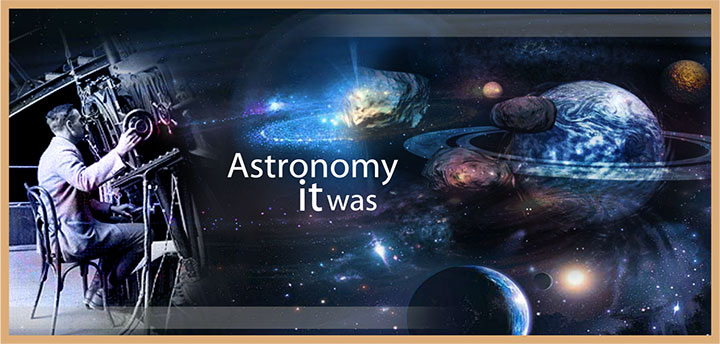

When Edwin joined the Mount Wilson staff, George Hale hiked his salary to $1500 a year, a good $300 more than what he had offered Edwin before the war. The atmosphere at Mount Wilson was nothing but electric. George Ellery Hale had almost single-handedly conceived and founded the Mount Wilson Observatory. He assembled a stellar team of astronomers – Walter Adams (Assistant Director), Adriaan van Maanen (Dutch astronomer), Harlow Shapley (a brilliant astronomer from Missouri), Milton Humason (self-taught astronomer and school dropout), among many others. Hale then went on to inspire his talented team, to make Mount Wilson Observatory the premier research institution in the field of Astronomy. The largest 100-inch reflector telescope then, made Mount Wilson every astronomer’s dream abode for work. Edwin joined the team and settled down very quickly in his new job.
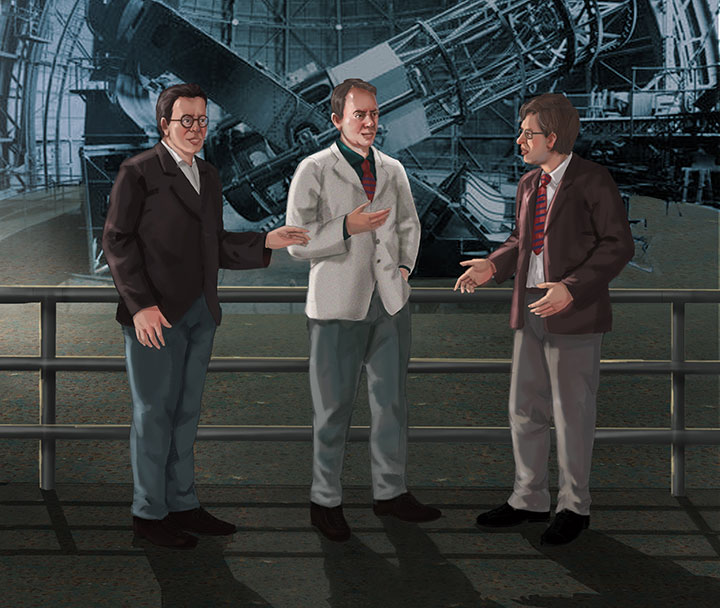
But the headstrong and maybe even intellectually arrogant hot blooded Edwin had a long and bitter rivalry with both Shapley and Adriaan van Maanen; brilliant astronomers but temperamentally incompatible. Edwin of course had a good equation with Milton Humason with whom he went on to successfully collaborate on many projects. Edwin’s complete body of scientific work in the field of Extragalactic and Nebular Research that consumed his entire working life was done at Mount Wilson. There was however a brief interruption in his long stint at the observatory – during World War II – when he left to do war work.

The month of June of the year 1920 had love in the stars and brought some visitors to Mount Wilson. And among them was the soon-to-be Mrs. Edwin Hubble. William H. Wright (astronomer at the Lick Observatory) had come on an invitation from George Hale, for some work on the 100-inch reflector telescope, accompanied by his wife Elna Wright and sister-in-law Grace Leib. Elna introduced Edwin to Grace, and sparks flew. Grace was struck by the astronomer’s commanding presence and rugged handsome look. Much later, Grace remembered the first ever description of Edwin she got from William Wright on her way to Mt. Wilson, “He is a hard worker, he wants to find out about the universe, that shows how young he is.” Grace was the daughter of prominent Los Angeles banker John Patrick Burke. An accomplished horsewoman, she loved literature and was an English major from Stanford. Grace was already married when she first met Edwin at Mt. Wilson. Her marriage to Earl Leib in 1912 lasted for eight years and the couple had no children. Then in June 1921, Earl died in a coalmining accident and Grace was left a widow. However, a year after Earl’s death, Grace and Edwin got romantically involved. The courtship was very discreet. Edwin visited Grace at her home, and often read to her in the library in the presence of her parents. On February 26, 1924, Edwin and Grace tied the knot and it was a very happy marriage. Unfortunately, their first and only child – a boy – turned out to be a stillborn though they never let this ordeal get in the way of their affection for each other. Grace was a witty and prized correspondent, always supportive of Edwin’s career.
By the late 1920s, Hubble’s career was taking off, and he was steadily moving up the ranks at Mount Wilson. Consequently, his annual salary shot up significantly. Besides, his lecture tours earned him a steady income. His comfortable house at San Marino’s Woodstock Road was a wedding gift from his wife’s side. Grace’s former husband was a wealthy man, and after his passing away she had come into considerable wealth; apart from the inheritance from her father’s side. All these resources pooled welcomed a stable financial position for the rest of their lives.
Edwin’s launching career and marriage to Grace became top priority and family (kin) took a backseat, leaving Edwin’s bachelor brother William to take responsibility of the family. Understandably, this led to some resentment amongst the family members. Edwin’s sister Elizabeth, later philosophically remarked, “I always wondered if Edwin didn’t feel guilty about not having done more. But great men have to go their own way. There is bound to be some trampling. We never minded.”

At this stage, it would be appropriate to take a detailed look at Edwin’s research work, which very much defined his life and earned him worldwide renown and recognition. His illuminating work in the field of Extragalactic and Nebular Research has not only stood the test of time for well over six decades, but very much set the tone for future work in this area of Astronomy. The approach was more speculative and philosophical at the time. Edwin with his observational approach to Astronomy, and reliance on scientific analysis of empirical data brought about a paradigm shift in the field. Nebular Research, before Edwin’s time, was restricted to mainly cataloguing the faint objects, and there was only speculation as to their nature. This was largely due to the limitations of the moderate-sized telescopes available then, which were incapable of studying the distant nebulae in detail. Edwin started with the 60-inch telescope at the Mount Wilson Observatory, but by the end of 1923 he began using the then new 100-inch reflecting telescope. Some of his important contributions in this field are as follows:
1: Photographic Investigations of Faint Nebulae (1920):
In the first two decades of the 20th century very little was known of these faint nebulae. They were neither classified nor precisely defined. Edwin did a detailed statistical study of these faint nebulae based on the vague markings on the photographic plates exposed with the 24-inch reflecting telescope of the Yerkes Observatory. Till then, only 76 nebulae were known in clusters. Edwin added another 512 in seven well-defined clusters, and went on to classify them according to form, brightness and size. He also accurately measured their positions.
2: A General Study of Diffuse Galactic Nebulae (1922):
In this paper, Edwin presented important information obtained with the Mount Wilson telescopes. He first proposed a clear classification system of nebulae, based on the fundamental differences between galactic (a nebula in the Milky Way Galaxy is known as galactic nebula) and non-galactic nebulae. His research got more detailed and thus required additional subdivisions.
3: The Source of Luminosity in Galactic Nebulae (1922):
Edwin continued with his study of the galactic nebulae, and came up with the observational evidence to back his theory on the origin of luminosity amongst galactic nebulae. He collected data on the angular extent of the luminosity (measure of apparent luminosity, measured in angles) for 82 nebulae along with their apparent brightness, and studied their relationship. The paper also included a study of the planetary nebulae and showed that luminosities of the planetary nebulae do not follow the same relationship as in galactic nebulae.
4: NGC 6822 (a distant cluster of nebulae) a Remote Stellar System (1925):
In this paper, Edwin focused on his favourite subject (extragalactic nebulae). When he trained his telescope on the NGC 6822, he found it to be a “faint irregular cluster of stars with several small nebulae”. On further examination he was able to identify eleven Cepheids within the group. (A Cepheid is a type of star with a known varying brightness that can be used to measure their distance. This method of measuring distances is known as the Cepheid Criterion.) Then by using the Cepheid Criterion he found the distance of the Cepheids, and thereby the distance of the NGC 6822 nebulae cluster. Then from the star counts and measurements of surface brightness, he determined the absolute luminosity (Objects of same luminosity located at different distances from us will have different apparent luminosities. So therefore there is a need to define absolute luminosity, which is the apparent luminosity an object would have at a certain distance, which is arbitrarily adopted as 10 parsecs. A parsec is a unit of distance equal to 3.26 light years), and mean density of the system and compared the same with that of the Magellanic Clouds (Irregular dwarf galaxies visible from the southern hemisphere, which are members of our local group and are orbiting our Milky Way Galaxy). Importantly he found that the Cepheid Criterion was working consistently even at such great distances, and the ‘Principle of Uniformity of Nature’ (which supposes that any other equal portion of the Universe chosen at random will exhibit the same general characteristic) was undisturbed in the remote regions of space. The study was thus critical in establishing the extragalactic distance scale.
5: A Spiral Nebula as a Stellar System – Messier - 33 (1926):
Edwin studied the nearest non-galactic nebulae by stretching the 100-inch reflector telescope at Mount Wilson Observatory to its full capacity. Edwin was then able to identify 45 variables (stars) and 2 novae (a star that suddenly becomes brighter due to a cataclysmic eruption, and then gradually returns to its original brightness over a period of weeks to years). Further investigation proved, that the Cepheid Criterion worked consistently even in remote space.
6: Extragalactic Nebulae (1926):
In Part I of this paper Edwin presented a detailed study on his classification of extragalactic nebulae. He emphasized that the classification was descriptive and not based on any theory. The classification system was later revised by Edwin himself, completed by Allan Sandage (American astronomer and Edwin protégé) and is prevalent till today.
Part II of the paper covered a detailed statistical study of 400 extragalactic nebulae. Edwin then gave a detailed analysis of the relationship between luminosities and diameters of spiral and elliptical nebulae. Further in those extragalactic nebulae in which individual stars could be clearly located, Edwin used them as distance criteria (luminosity-distance relation similar to Cepheid Criterion) to estimate the distance of the extragalactic nebulae. Finally, using the evidence available to him, Edwin calculated the mean density of the nebulae in space. He then applied the same to arrive at an estimate of the radius of curvature of the finite universe, which was - “600 times the distance at which normal nebulae can be detected with the 100-inch reflector telescope”. This was a very bold and imaginative probe into the unknown at that time, and it sparked off a lot of further theoretical work in Cosmology.
7: A Spiral Nebula as a Stellar System, Messier-31 (Andromeda Nebula) (1929):
This 55-pages long paper, presents a detailed discussion on the Andromeda Nebula. Edwin located 40 Cepheids in the Andromeda Nebula (Messier-31). His efforts in measuring the distances of remote nebulae conclusively proved that there are millions of galaxies like our Milky Way in the Universe, and the Universe is much bigger than what it is thought to be. It was like sticking a deep probe into the vast depths of a seemingly infinite Universe. Though there were earlier views and suggestions that the Universe extended much beyond the Milky Way Galaxy, Edwin’s findings were the conclusive proof. Edwin then proceeded to make a detailed study of the characteristics of the 85 novae of the Andromeda Nebula. Edwin was unable to fully study the nuclear region of the Andromeda Nebula due to the limitations of the 100-inch reflector telescope. But based on available evidence, he broadly concluded the nebula as a star cloud, in which bright giants are rare in the centre compared to the outer arms of the spiral, where the giants are concentrated.
8: Distribution of Luminosity in Elliptical Nebulae (1930):
This paper was an early attempt to look at the actual distribution of luminosity in a select list of elliptical nebulae. He concluded that the nuclei of the nebulae were more concentrated and more luminous and as one moved towards the outer regions of the nebulae, the luminosity dropped faster than the density of the nebulae.
9: The Velocity-Distance Relation among Extragalactic Nebulae (with Milton L. Humason – fellow astronomer at Mount Wilson) (1931):
In Part I of this paper titled ‘Distances of Nebulae’, Edwin and Humason listed 10 extragalactic nebulae in which stars were identified. They used the luminosity criterion of the stars to work out their distances, and thereby the distances of the nebulae containing these stars. Thus, based on the brightest star in the nebula, they worked out a formula for the distance of the nebula. The measurement of brightness of nebulous object is a very difficult technical problem of photographic photometry. So Edwin and Humason used extra-focal exposures with the telescope, and this method gave results which were far more accurate.
In Part II of this paper titled ‘The Velocity-Distance Relation’, Edwin and his colleague Humason compiled data on over 40 nebulae and found a linear relation between distance and velocity. So greater the distance of the nebulae from us (Milky Way), greater is the velocity at which they are receding from us. This confirmed that the Universe was expanding. Edwin estimated the increase in velocity or expansion of the Universe at 500 kms per second per mega parsec of distance. The statement had a profound effect not only in the field of Astronomy, but even philosophically the concept of a rapidly and constantly expanding universe was mind-boggling. Edwin’s estimate of expansion was called the Hubble Constant. Since then, the Hubble Constant – based on recent findings – has been revised to 70 kms per sec per mega parsec of distance. However, the point to be noted is that the difference is only in degree and not in kind. Edwin’s principle and line of thought still holds true. Over a decade before this finding, Albert Einstein – the renowned physicist – had come up with his famous Theory of Relativity, which did point towards an expanding Universe. But Einstein modified his equations, since it contradicted with the available evidence at that time. So when Einstein heard about Edwin’s finding, he went all the way from Germany to Mount Wilson Observatory in California to meet Edwin. The great man then famously admitted that changing his equations was “the greatest blunder of my life”. This was indeed very high praise for Edwin, coming as it did from one of the greatest scientists of all times.
10: Nebulous Objects in Messier-31, Provisionally Identified as Globular Clusters (1932):
As Edwin continued his nebular studies, he discovered 140 ‘nebulous objects’ in and around the Andromeda Nebula. These objects were small, highly concentrated, round and symmetrical. So based on their structure, luminosity, diameters and colours, he provisionally identified them as globular star clusters.
11: The Surface Brightness of Threshold Images (1932):
Edwin studied both the nebular and stellar (star) images under threshold conditions with the 100-inch and 60-inch reflector telescopes and found that the surface brightness reduces as the size increases, initially very rapidly, but then gradually slowly and slowly. Thus, for very small images the surface brightness was independent of the size and also for very large images it was independent of size. So the observed relation moves smoothly between these limiting conditions. With this finding, he was to find more accurate brightness measurements of nebulae from those of stars used as standards.
12: Red-Shifts in the Spectra of Nebulae (1934):
The paper was delivered as the Halley Lecture of the Royal Astronomical Society in London, on 8th May, 1934, by Edwin. In this paper he initially discussed his various investigations in the realm of the nebulae. He then invoked the ‘Principle of Uniformity of Nature’ and advanced the thought that the realm of the nebulae was the Universe. He then went on to briefly explain that as the distance of the nebulae (from the Milky Way Galaxy) increases, the receding velocity of the nebulae (away from the Milky Way Galaxy) increases and that the light from distant nebulae is redder than normal, the light waves are longer, the vibrations are slower and the light quanta lose energy. This phenomenon of red-shifts, without any other attendant effects, can only be explained due to actual motion of the nebulae away from us. But the cautious astronomer in Edwin, went on to state that there is a possibility - however remote – that the red-shifts could be due to some “hitherto unrecognized principle of Physics”. However, theoretical investigators since then, almost universally accept Edwin’s proposition that the red-shifts are indicative of a receding motion by the nebulae.
13: The Distribution of Extragalactic Nebulae (1934):
Edwin referred to his work on distance estimates of the nebulae, as just a quick preliminary calculation. He then went on to say that the estimates needed to be followed up with a very detailed examination, with an eye on accuracy and completeness, and with a special emphasis on methods and procedures. He put up detailed information for the first time, on the occurrence of obscuring matter (nebulous objects) along the plane of the Milky Way Galaxy. He also gave details on the number of nebulae to successively fainter limits, the tendency of nebulae to cluster, and the average density of matter in the extragalactic space. All this new and vital information was of immense importance to further studies in the field. This paper generally recognized as a classic, is widely referred to in many subsequent works by various scientists.
14: Two Methods of Investigating the Nature of Nebular Red-Shift (with Richard C. Tolman of California Institute of Technology (1935):
This was another of Edwin’s collaborative effort, this time with Richard C. Tolman of the California Institute of Technology.
In Part I of the paper, the duo stressed on their empirical approach to the analysis of nebular red-shifts. They stated that they had an open mind as regards to the ultimately most satisfactory explanation of the nebular red-shift. This showed their willingness to look at other explanations for the phenomenon of red-shifts, other than their own of ‘velocity of recession’. They eliminated the direct use of the distance parameter in the formula, by connecting “either nebular dimensions with observed luminosities or nebular counts with observed luminosities”.
In Part II of the paper, they objectively presented the existing status of the observational work in this area. They then referred to in great detail, the uncertainties in the counts of galaxies, difficulties in determining the number of nebular images per plate, in evaluating exactly the red-shift, etc.
15: Effects of Red-Shifts on the Distribution of Nebulae (1936):
In this paper Edwin studied two additional groups of nebulae. After a thorough analysis of observational data and comparison with previous models (worked out with Tolman), Edwin reported that the observations could be fitted into either of the two possible types of our Universe: a) If the red-shifts are velocity-shifts (i.e. due to increasing recession velocity), then it is indicative of an expanding Universe; which is relatively closed, small and dense, and the rate of expansion is decreasing steadily. b) On the other hand, if the red-shifts are not due to velocity-shifts, then it indicates that the Universe is not expanding, the velocity-distance relation is linear (i.e. the velocity increases in proportion to increase in distance), and the distribution of nebulae is uniform.
16: The Luminosity Function of Nebulae (1936):
In this paper, Edwin attempted to estimate the luminosity function for the nebulae by two separate methods as follows: a) The luminosity function of resolved nebulae (i.e. in which stars are identified) as indicated by their brightest stars. This method uses the criterion of the brightest star in a nebula (which is the mean of three or four of the brightest objects, judged to be individual non-variable stars located in a nebula). b) The luminosity function as indicated by residuals (differences between predicted and observed values of same quantity) in velocity-magnitudes relation. Edwin reported that the velocity-magnitude relation could be used to determine individual distances of nebulae.
17: The Motion of the Galactic System among the Nebulae (1939):
Edwin analyzed the residual radial motions (radial motion is motion in which the body moves along a line connecting with an observer or reference point) of the nebulae, after removing the systematic red-shifts (after removing or accounting for the effects of red-shifts).
18: The Direction of Rotation in Spiral Nebulae (1943):
During the detailed study of the nearby nebulae Edwin discovered four spirals amongst them, in which the direction of rotation as well as the tilt of the spiral rotation could be clearly determined from the silhouetting against the bright nuclear regions. He found 15 other spirals in which spectrographic rotations were observed. In these the spiral arms could be clearly traced, and the dissymmetry of obscuration gave a general criterion of tilt. From this, Edwin concluded that all nebulae seem to be rotating in the same direction. He also found, that in all these nebulae the spiral arms were trailing i.e. the outer parts rotate much slower compared to the inner regions of the spiral nebulae.
19: First Photographs with the 200-inch Hale Telescope (1949):
Edwin was closely involved in the design of the 200-inch Hale Telescope. He was very excited about the new telescope, and had said in a BBC broadcast in London, “With the 200-inch, we may grasp what now we can scarcely brush with our fingertips.” Edwin was given the honour of the first use of the Hale Telescope. On January 26, 1949, at about 10 pm – Edwin Hubble recorded the first photograph with the Hale Telescope - NGC 2261 – a galactic nebula. It is now known as the Hubble’s Variable Nebula, as he had discovered the remarkable changes in its brightness. Edwin Hubble reported that the initial photographs taken while testing the new 200-inch telescope recorded nebulae and stars, a full 1.5 times fainter than those possible at the extreme limits of the 100-inch telescope. Also, at high galactic latitudes the 200-inch Hale Telescope recorded more nebulae than stars, as Hubble had predicted many years earlier.
20: Explorations in Space: The Cosmological Program for the Palomar Telescope (200-inch Hale Telescope) (1951):
Hubble was well aware of the limitations of the 60-inch and 100-inch telescopes and since he was actively involved in the design of the 200-inch Hale Telescope, he was probably the best-placed man to draw up the programme for the new telescope at Mount Palomar. When Hubble was asked as to, “What he expected to find with the 200-inch?” his reply was, “We hope to find something we hadn’t expected.” And sure enough he didn’t disappoint. In this paper Hubble summarized the extragalactic research done till then, and spelt out very clearly the programme for the great Palomar Telescope as follows: “The cosmological programme for the Palomar Telescope has been formulated to get new answers to the observational problems, free from systematic errors, and with the accidental errors sufficiently small to be unimportant. Specially the problems are, first, to find the mean density in space, and the rate of increase of red-shifts in our immediate vicinity – say within fifty million light years of our own system – and second, to determine whether or not there are any appropriate systematic changes with distance or direction in either of the two data.” His words give us an insight on his amazing grasp of the subject of extragalactic research.
21: The Law of Red-Shifts (1954):
Hubble delivered this paper as the George Darwin Lecture on May 8, 1953, in London. Here, Hubble traced the history and emergence of the law of red-shifts – from the discovery phase (1928 – 1929) which ended with a crude formulation, the rapid extension phase (1929 – 1936) leading to improved formulation up to the limits of the 100-inch telescope, and finally the recent phase of a more definitive formulation of the law with the aid of the 200-inch reflector telescope.

Hubble’s views on the future of extragalactic research are worth noting for his acute foresight and mastery over the subject. It reads as follows, “As for the future, it is possible to penetrate still deeper into space – to follow the red-shifts still farther back in time – but we are already in the region of diminishing returns; instruments will be increasingly expensive, and progress increasingly slow. The most promising programmes for the immediate future accept the Observable Region as presently denned, hope for only modest extensions in space, but concentrate on increased precision and reliability in the recorded description. The reconnaissance is being followed by an accurate survey; the explorations are pushed towards the next decimal place instead of the next cipher. This procedure promises to reduce the array of possible worlds as surely as did the early inspections of the new territory. And later, perhaps in a happier generation, when the cost of a battleship can safely be diverted from insurance of survival to the consolations of philosophy, the march outward may be resumed.
For I can end as I began. From our home on the Earth, we look out into the distances and strive to imagine the sort of world into which we are born. Today we have reached far out into space. Our immediate neighbourhood we know rather intimately. But with increasing distance our knowledge fades, and fades rapidly, until at the last dim horizon we search among ghostly errors of observations for landmarks that are scarcely more substantial. The search will continue. The urge is older than history. It is not satisfied and it will not be suppressed.”

The brief interruption in Hubble’s long stint at the Mount Wilson Observatory was due to World War II. Hubble itched to get back into the army. A most unusual choice for a man in his mid-fifties and well settled in his life and career. But then it is already established that Hubble was no ordinary man. He tried to join the infantry but was called in by the Army Ordnance and told, that given his research background he was already earmarked for a posting at the Ballistics Research Laboratory, in Maryland’s Aberdeen Proving Ground. So in the summer of 1942, Edwin Hubble left to serve as the Chief of Exterior Ballistics and Director of Supersonic Wind Tunnel, at the Ballistics Research Laboratory. After the war, Edwin Hubble was awarded the ‘Medal of Merit’ in 1946, for his valuable service to the country.

Edwin Hubble and his wife Grace led a very active social life. The Hubble’s home at San Marino’s Woodstock Road was always teeming with visitors. Hubble liked to bring distinguished guests home, and Grace played the ever-gracious hostess to perfection. The visitors included leading scientific men like Quaker Arthur Eddington, James Jeans (President-Elect of the Royal Astronomical Society and Research Associate at Mt. Wilson), famous English actor George Arliss and many others. But the most famous visitor the Hubble household had was undoubtedly Albert Einstein. Grace was assigned the role of unofficial hostess to the great man. One afternoon when she was driving him to some function, her normally quiet visitor surprised her when he turned and said to her, “Your husband’s work is beautiful – and – he has a beautiful spirit.” Hubble’s research work and visits by leading scientific men like Einstein made Mount Wilson famous, and it attracted a lot of people from all spheres.
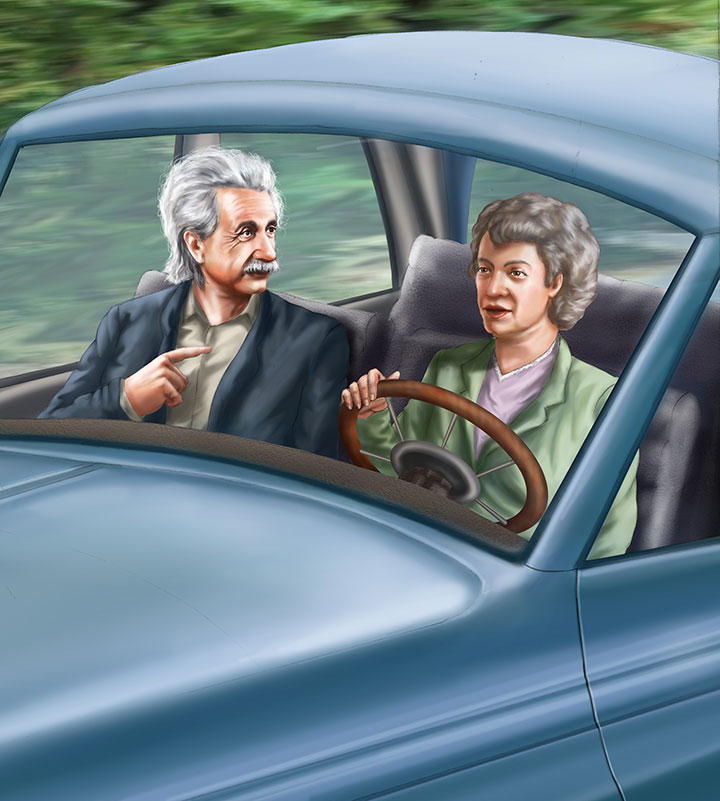
The Hubbles were also active in the Caltech Faculty Club – The Athenaeum – which was modelled after the famous Athenaeum Club of London. The club hosted distinguished scientific and literary individuals, apart from various artists. Hubble was also very active on the lecture circuit. Hubble’s growing fame meant a wide range of acquaintances across the world, even from outside the scientific community, like Aldous Huxley (English writer), H.G.Wells (English novelist) to famous film personalities like the legendary Charlie Chaplin, Frank Capra (American film director), Anita Loos (American screenwriter and playwright), Leslie Howard (English actor) among many others.

Even in the midst of a busy research career, Hubble had many varied interests and he pursued them actively. He was elected to the National Academy of Sciences in 1927. He was elected to the Board of Trustees of Huntington Library in 1938. He was instrumental in organizing the Los Angeles Committee on Foreign Relations, and served as a member and its chairman. Hubble had a keen interest and considerable foresight in political and international affairs. He figured out very early that the European Policy of Appeasement in the 1930s was flawed, and that United States would be drawn into the war. When Germany fired the first salvo signalling war, Hubble remarked, “This is a world war and we are in it.” In fact, in the months before the United States finally stepped into the theatre of war, Hubble went around the country advocating the immediate entry of the United States in the war as an ally of Great Britain. In mid-1941, when Hubble was introduced to a couple of visiting Englishmen as ‘Pro-British’, he snapped, “Hell I’m for civilization.”
Hubble was also a very eloquent and engaging speaker, and had the rare gift of making his audience believe in him. An incident in the March of 1933 at Pasadena, California, bears testimony to his prowess as a confident and engaging speaker. A damaging earthquake had occurred in Pasadena. There was utter panic at the Huntington Hotel, and guests wanted to get out of the place as quickly as possible. The hotel manager, a friend of Hubble, called him to try and calm the alarmed guests. Hubble’s initial reaction was to get a professional from the Cal Tech Seismology Laboratory, but the manager insisted that Hubble come and talk to the guests. Finally Hubble agreed, he told them, that they were indeed fortunate to have experienced the earthquake without suffering any damage. He explained the geological history of Southern California and locations of the major faults, and that only poorly planned and constructed buildings were prone to any damage. Hubble then assured the guests, that he and the manager had inspected the hotel building in the morning, and they need not have any worry. Of course, he conveniently forgot to tell them, that the hotel and his own house were built right on top of an earthquake fault (which was later named as ‘Huntington-Hubble fault by a Cal Tech geologist). Hubble’s talk convinced the guests adequately, and saved the season for the Huntington Hotel.
Hubble had a deep interest in Science, Philosophy and loved reading. His library had many books covering his three principal interests – Nicolas de Cusa (1401 – 1464; German philosopher, mathematician and astronomer), Giordano Bruno (1548 – 1600; Italian Dominican philosopher, mathematician and astronomer) and selections from Chinese Science and Philosophy. Hubble also read widely on the history of science. He strongly believed that whenever possible, one should always go to the source material, as books written by the people themselves are far more significant and valuable, than those written about them. Finally, he donated his library to the Mount Wilson Observatory.
Hubble was a very fine writer. His writing was marked with clarity, a simple but engaging style of writing, and the rare ability to make complex scientific concepts accessible to even common people. His two books, ‘The Realm of the Nebulae (1936)’ and ‘The Observational Approach to Cosmology (1937)’ were extremely well received by both, the scientific community and the general public as well.

In the July of 1949, at the age of sixty, Hubble suffered an attack of coronary thrombosis (form of blood clot affecting brain), while on one of his fishing trips to Rockies. He recovered under the loving care of his wife and returned to work. In May 1953, Hubble went on a lecture tour to England, where he gave the George Darwin Lecture, the Cormac Lecture of the Royal Society of Scotland, and a lecture at the Royal Institution of Great Britain. In Paris he attended a meeting of the Institut de France, of which he was an active member. He then returned home to continue his research work at the Mount Wilson and Palomar Observatories. On September 28, 1953, Hubble suffered from a second attack of cerebral thrombosis while his wife was driving him home from work. This time the attack proved fatal. He was sixty-four when he breathed his last. Thus the world of Astronomy lost a brilliant practitioner, much before his time.

Edwin Hubble had been courting greatness in his field of Astronomy for well over three decades, and was a highly decorated man. He was awarded the honorary degree of ‘Doctor of Science’ by the Oxford University in 1934. He received the Barnard Medal in 1935, at Columbia University, by the National Academy of Sciences. Yet, he missed the greatest prize in his lifetime – The Nobel as during that time, the Nobel was not awarded to practitioners of Astronomy. In his last few years, Hubble campaigned hard to have Astronomy included as a branch of Physics. This was logical as Astronomy and Physics are closely related. But it was only in 1953, shortly after Hubble’s death, Astronomy was declared as a branch of Physics and thus became an eligible field for the Nobel Prize. However, as the Nobel Prize is not awarded posthumously, Edwin Hubble missed out. It was a bit unfortunate, as his name was very much in the reckoning with the Nobel Committee.

Edwin Hubble had achieved ‘astronomical’ stardom with his path breaking research work, and tributes flowed generously. The asteroid ‘2069 Hubble’ is named after him. There is a crater named ‘Hubble’ on the moon. But undoubtedly, the finest tribute to the great astronomer is - The Hubble Space Telescope – launched by NASA in April 1990.
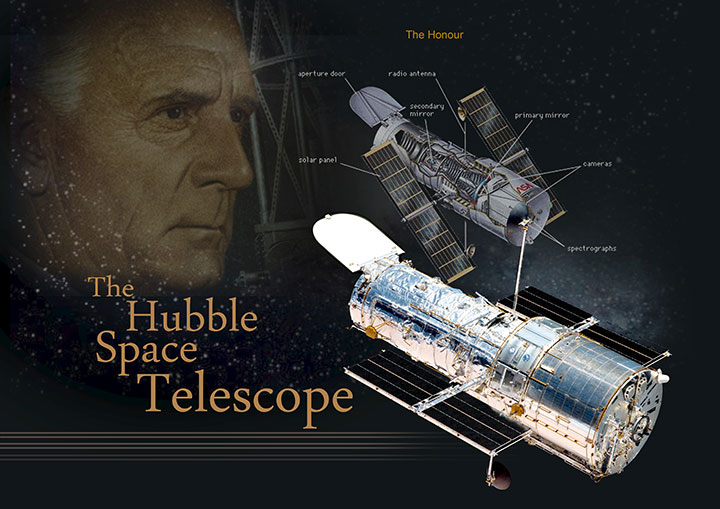
It is a large space based observatory, orbiting far above the disturbing effects of the earth’s atmosphere. It continuously scans the vast space above and returns valuable scientific data from our own solar system, as well as from other remote galaxies. In a small way the ‘Hubble Space Telescope’ ensures that Edwin Hubble’s enduring romance with the Universe continues for a long time to come.
Next Biography








